
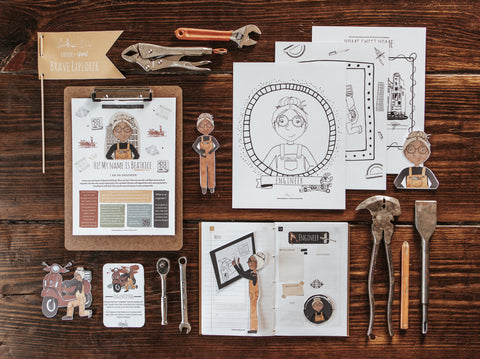
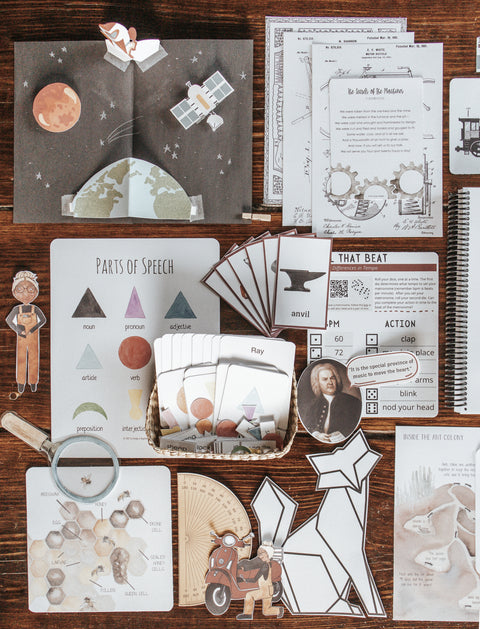
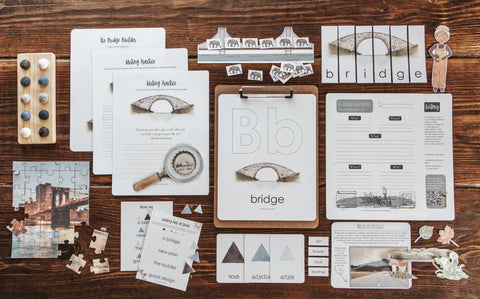



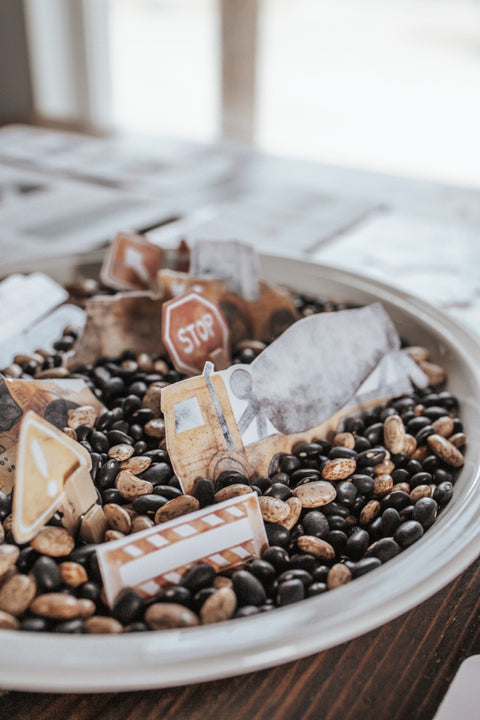
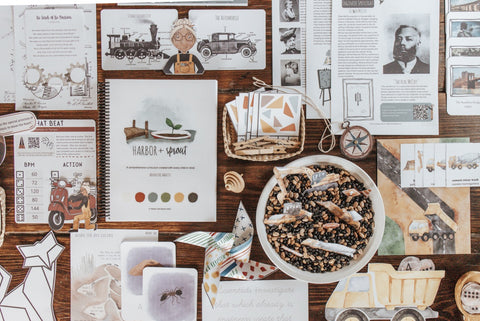
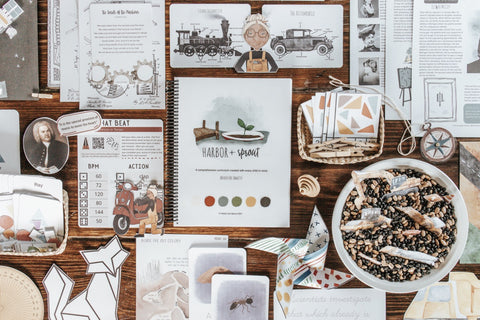
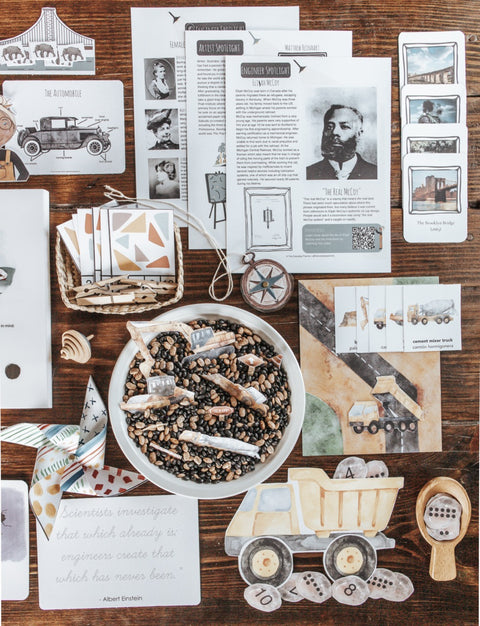
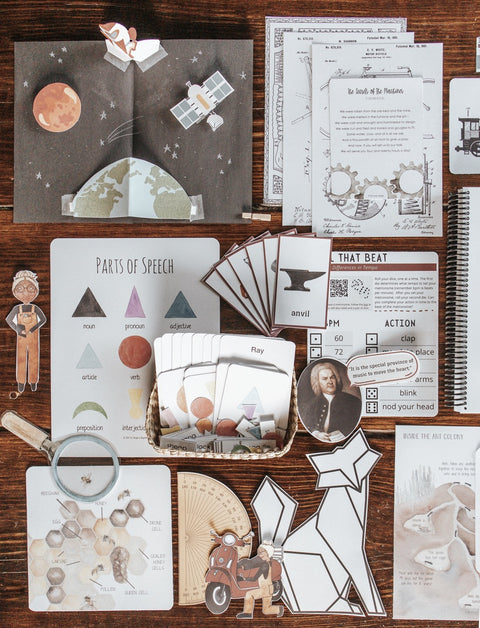
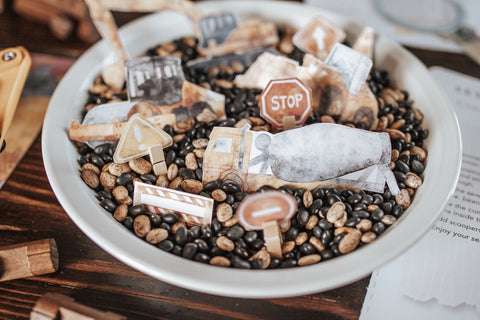

Harbor and Sprout
Engineering Patchwork Study
Welcome to the Harbor + Sprout Engineering Patchwork Study, originally released in September 2021 and updated August 2025. This unit study features 4 weeks of lesson plans and materials covering all 9 of our core subjects plus a playful supplemental section of thematic activities. This unit study is meant for use by children ages 3-12.
This unit is delivered via a secure link as a digital download.
CONTENT:
Handbook
Daily, weekly, and monthly planning pages
Book list including stories, poems, and field guides with recommended ages, subject correspondence, and brief summaries for each title
Lesson plans for 4 levels of learning
Family read aloud with discussion guide and recipe
Character kit- new monthly character illustrated by Stephanie Groves
Science
Lesson 1: What is Engineering? In this lesson, you will discover different types of engineers and what they do. You will color and trace how engineers work, match and identify the engineering design process, and challenge yourself like an engineer.
Lesson 2: Can Engineers Help Stop Pollution? In this lesson, you will explore the mission of environmental engineers to help create a cleaner, healthier planet. You will test how well a surfactant can clean, build a hydropower wheel, and demonstrate Pascal’s Law.
Lesson 3: Can Engineers Make Power? In this lesson, you will dive deeper into all the ways we use electricity in our daily lives and electric engineers. You will color and trace nuclear fission, make your attempt at an egg drop challenge, and build a wind turbine.
Lesson 4: How do Engineers Shape Communities? In this lesson, you will learn a little bit more about the four components of flight and the innovative engineers who advance the field. You will make a balloon rocket, conduct a plane launcher test, and design a wildlife bridge.
Nature Study
Lesson 1: What is a Beaver? In this lesson, you will explore a little bit about the world’s second largest rodent and nature’s engineer – the beaver. You will practice your spelling skills and research rodents in your area and around the world.
Lesson 2: Tools of the Trade- In this lesson, you will learn that beavers are born builders due to their specialized teeth, adapted front paws, webbed hind feet, semi-aquatic bodies, and their large flat tail. You will combine a beaver’s tools with our tools.
Lesson 3: The Beaver Dam- In this lesson, you will discover how and why beavers build dams. You will watch a beaver build a dam and then it will be your turn to build a dam with items you can find around your area and within your home.
Lesson 4: The Beaver Lodge- In this lesson, you will discover how and why beavers build lodges. You will learn the differences between the dams and lodges, identify parts of a lodge, design your own beaver lodge, and then build your own.
History
Lesson 1: Early Engineering in Rome- In this lesson, you will discover the beginnings of Engineering and invention. You will dive deeper into the Roman aqueduct system, how it came to be, why it was important, and how principles of its design are still used today.
Lesson 2: The Steam Engine- In this lesson, you will explore the long, interesting history of the steam engine. You will learn how it has developed over the years, the people who were instrumental in its development, and its cultural significance.
Lesson 3: The Automobile and Developing Ideas- In this lesson, you will discover a brief history of the automobile. You will learn how automobiles changed and evolved over time and how three historically significant female inventors impacted automotive history.
Lesson 4: The Brooklyn Bridge- In this lesson, you will explore the fascinating history of the Brooklyn Bridge. You will learn about the connecting line of engineers who worked on it and how its construction marked the beginning of a new age in engineering.
Geography
Lesson 1: Solar Energy- In this lesson, you will explore solar energy -- how solar energy works, ways engineers have developed systems to utilize solar energy, how solar energy looks differently around the world, and the cutest solar farm in Datong, China.
Lesson 2: The Panama Canal- In this lesson, you will discover the cultural significance of the Panama Canal and how it changed travel around the Americas forever. You will learn a little bit about its construction and how the lock system works.
Lesson 3: The Power of the Wind- In this lesson, you will learn about another renewable energy source: the wind. You will learn about windmills, wind turbines, wind energy maps, and William Kamkwamba, otherwise known as the boy who harnessed the wind.
Lesson 4: Wildlife Bridges- In this lesson, you will explore wildlife bridges: why they were created, how they keep natural habitats intact, and consider some wildlife bridges around the world. You will dive into fun facts about Amsterdam, North Holland.
Language Arts
Lesson 1: "The Bridge Builder"- In this lesson, you will understand and appreciate the poem “The Bridge Builder” by Will Allen Dromgoole, which is about hard work, generosity, and caring for others. You will read, retell, summarize and discuss the poem.
Lesson 2: Parts of Speech- In this lesson, you will understand different parts of speech (including nouns, pronouns, adjectives, articles, verbs, adverbs, prepositions, conjunctions, and interjections) and recognize their associated grammar symbols.
Lesson 3: Rhyming Words- In this lesson, you will identify, hear, and produce rhyming words. You will explore how word families affect rhyming words, how rhyming words in poetry assist with rhythm, and read an excerpt from The Secret of the Machines.
Lesson 4: New Words- In this lesson, you will understand how new words become part of the English language by compounding, reduplication with rhyming and differing vowels, and conversion. You will get your turn to make your own new words.
Writing
Lesson 1: Brainstorm and Prewrite- In this lesson, you will begin the writing process by choosing an engineering based topic (suggestions available or come up with your own), formulate 3 questions to research, and find 3 reliable sources for researching.
Lesson 2: Research and Outline- In this lesson, you will continue the writing process by gathering resources to answer the questions you posed, develop a thesis statement with 3 supporting details, and plan the paper’s structure.
Lesson 3: Write your First Draft- In this lesson, you will continue the development of this paper by writing the initial draft. In this section, you will be focusing on simply getting thoughts down and using the outline and research notes as guides.
Lesson 4: Revise, Edit, and Proofread- In this lesson, you will finalize your paper on engineering by rereading the first draft to ensure the topic question is answered, proofreading the revised draft for errors in spelling, grammar, etc, and write your final draft.
Music
Lesson 1: Engineering Musical Instruments- In this lesson, you will explore the fascinating world of musical instrument design. You will learn how engineers harness vibrations, materials, and tuning to craft traditional instruments, shaping the sounds we hear.
Lesson 2: Opera House and Concert Hall Acoustics- In this lesson, you will dive into the fascinating world of acoustics in opera houses and concert halls. You will explore how acoustics influence the experience of live performances and the ways engineers ensure notes are heard perfectly.
Lesson 3: Acoustic to Electric Revolution- In this lesson, you will journey through the evolution of musical instruments, from acoustic to electric and digital instruments. You will explore how technology has transformed music-making.
Lesson 4: Engineering Sound for the Big Screen- In this lesson, you will explore musical performances in movies and how engineers transform music into film soundtracks, mastering the art of sound design to craft audio that enhances the visual experience.
Art
Lesson 1: Art Elements- In this lesson, you will explore the wonderful world of color theory. You will learn how complementary colors can be used to make grey, how grey is used in art to evoke the right emotion, and ways grey is found in nature.
Lesson 2: Technique- In this lesson, you will discover how engineers and artists alike factor force and movement into their designs and the different ways they address it. You will learn about how a whirlybird works and then create your own.
Lesson 3: Principles of Art and Composition- In this lesson, you will explore the principles of art and elements of composition, including unity, balance, emphasis, movement, rhythm, pattern, and contrast. You will look at examples of classic art pieces.
Lesson 4: Paper Engineers- In this lesson, you will discover writer, illustrator, and paper engineer Matthew Reinhart, who co-created bestselling pop-up books. You will create your own masterpiece with movement by making your own pop-up book.
Math
Lesson 1: Exploring Angles- In this activity, you will explore the different angles, including, acute, right, obtuse, straight, reflex, and full rotation, and learn how to measure angles with a protractor. You will consider the importance of accurate calculations to engineers.
Lesson 2: Proportions and Equations- In this activity, you will discover several ways to relate numbers to each other with numerical digits, numerical words, ten frames, fractions, and decimals. You will also create equations and their answers.
Lesson 3: Exploring Triangles- In this activity, you will dive into the wonderful world of triangles. You will learn that triangles can be classified by the degrees of their angles and by the lengths of their sides and use basic algebra to calculate the missing angle of a triangle.
Lesson 4: Mean, Median, Mode, and Range- In this activity, you will explore how engineers use math to learn more about the world. You will learn the difference between the mean, median, mode, and range of a set of data, and also how to calculate each one.
Supplement
Nature Activities
Animal Builders Copywork
Animal Builders Tracing Cards
Fairy Houses
Garden Maze Coloring Poster
Mushroom House Templates
Vintage Nesting Birds Cards
Wellness & Quiet Time
Construction Vehicles
Construction Zone Sensory Bin
Construction Zone Playdough Mats
Construction Zone Word Search
Writing & Language Arts
Vocabulary
Spelling Practice
Bridge Puzzles
Spelling Cards
Engineering Story
Copywork
Writing Process Reference Pages
Revision Practice
Coloring Pages
This unit will be delivered digitally as a downloadable zip file. H+S Patchwork Studies average approximately 550-650 pages of content. While the download does include the option to print the full unit straight through front and back, we recommend printing on an as-needed, as-you-go basis. Enjoy your engineering adventures!
